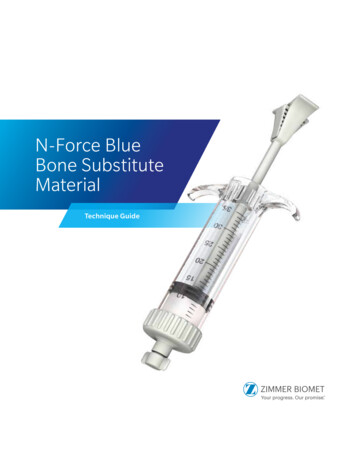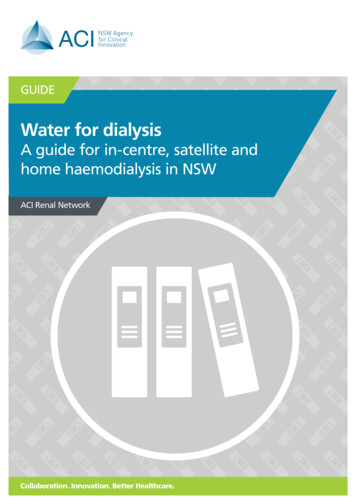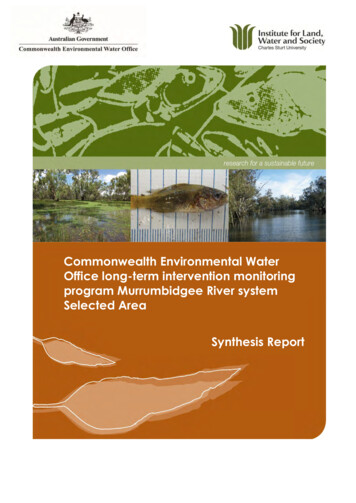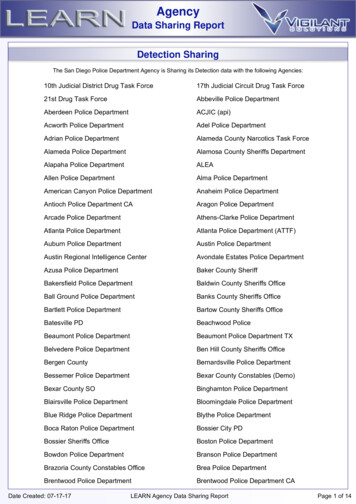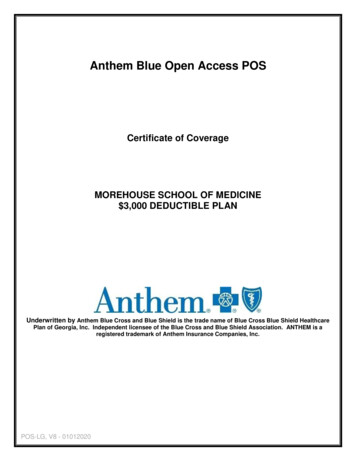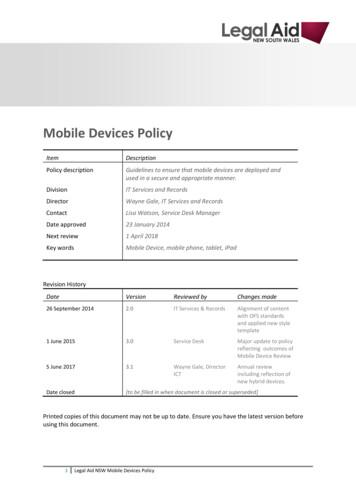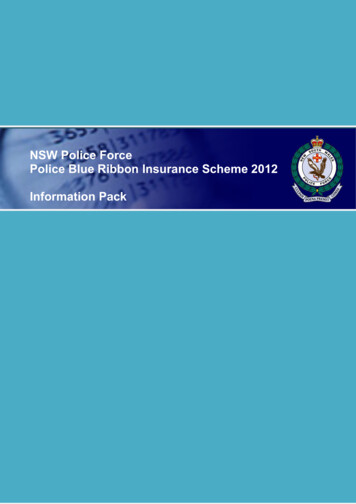
Transcription
NSW Police ForcePolice Blue Ribbon Insurance Scheme 2012Information Pack1
Contents1The Police Blue Ribbon Insurance Scheme (PBRI) – effective January 2012 .32Income protection .43Disability Tests .64State Authorities Superannuation Scheme (SASS) ABC .85Permanent Restricted Duties and Suitable Duties .86Previous Work Related Injury .97Superannuation .108Taxation.109How to lodge a claim .1110Documentation required for claims.1211Where can I obtain further information? .12AnnexuresPBRI Death Cover Scale.14PBRI TPD Cover Scale .152
1The Police Blue Ribbon Insurance Scheme (PBRI) – effective January 2012In January 2012 the NSW Government changed the insurance arrangements that provide death anddisability benefits to NSWPF officers who die or who are incapacitated as a result of being injuredwhile either on or off duty.These insurance arrangements replace the previous arrangements provided under the CrownEmployees (Police Officers Death & Disability) Award 2005.This scheme only applies to police officers employed after 1 April 1988, including probationaryconstables. Special arrangements will apply to some SASS members.The Police Blue Ribbon Insurance Scheme provides the following benefits: A lump sum benefit should an officer die while either on or off duty. See Annexure A – PBRIDeath Cover Scale A lump sum benefit if an officer is totally and permanently disabled due to an injury that occurswhile the officer is either on or off duty. See Annexure B – PBRI TPD Cover Scale An income protection benefit for on duty injuries begins after a nine month waiting periodfollowing injury (during which time an officer’s salary is maintained at 100% by the NSW PoliceForce). The on duty income protection benefit will provide 75% of base salary (plus 17% loading) fornon-commissioned officers and 75% of award salary for commissioned officers for up to fiveyears and will commence immediately after the nine month period at 100%. The income protection benefit for off duty injuries will commence after a sixty day waitingperiod following injury (the officer will use available sick leave during this time) and will providenon-commissioned police officers with 75% of their base salary (plus 17% loading) and 75% ofthe award salary to commissioned officers for up to two years.Ongoing payment of the income protection benefit will be subject to the insurer’s assessment of theofficer’s fitness to work.In the event of a total and permanent disability the insurance policy will pay both the lump sum benefitand the income protection benefit, which can be commuted to a lump sum at the insurer’s discretion.An officer need not be medically discharged to be eligible for these benefits.Other benefits provided under the insurance policy include: A rehabilitation expense benefit to support an injured officer’s rehabilitation and return to work,either with the NSW Police Force or an external organisation. The insurer will pay the costs ofan approved rehabilitation program direct to the rehabilitation provider in addition to theincome protection benefits. A recurrent disability benefit – if an injured officer returns to work after a period of disability,but their injury re-occurs or deteriorates to a point that they have to leave work again, they canrecommence their benefits without a further waiting period.Police officer contributions to the cost of the insurance policy will remain capped at 1.8% of salary andwill continue to be made by way of a pre-tax salary sacrifice.3
2Income protectionUnlike death, terminal illness and total and permanent disablement (TPD) cover which are providedon a lump sum basis, income protection (IP) provides a monthly income replacement benefit. IP isavailable for accepted on duty and off duty claims and is provided by the insurer, TAL Life Limited(TAL).The IP monthly benefit is calculated based on the officer’s salary as at the date of disability ratherthan the current rate of salary. Under IP, officers will be entitled to receive up to 75% of their salary(salary is defined as base salary plus 17% loading for non commissioned officers). Commissionedofficers are entitled to up to 75% of award salary. If an officer is working part time at the date ofdisability, then the salary is proportioned accordingly.Secondary income derived through personal exertion will also be considered when the insurer iscalculating the amount of IP benefit payable.IP will be paid for up to a maximum of 5 years for on duty claims and for a maximum of 2 years for offduty claims.2.1 Waiting periodsThe waiting period is a continuous period which commences from the date a medical practitionercertifies the officer as totally disabled on a medical certificate. The waiting period is required beforeany IP payments can commence.The waiting period is 270 days for on duty claims and 60 days for off duty claims. During the waitingperiod, officers are to use their available leave, e.g. worker’s compensation, sick, annual, additional orextended. Should these leave types be exhausted, an officer will take leave without pay. After thewaiting period, officers may commence IP upon acceptance of their claim by the insurer.2.2 Impact on incomeOnce an officer’s claim has been accepted by the insurer, the monthly disability benefit is payablefrom the first day after the waiting period. The IP benefit is then paid monthly in arrears. This meansofficers will receive their first IP payment one month after the date their claim has been assessed andapproved by the insurer (after the waiting period).At the end of the waiting period for on duty claims, officers will be placed on the statutory rate. Thestatutory rate is the amount as specified in section 37 of the Workers Compensation Act 1987 and isindexed in April and October each year. This payment will be paid in the fortnightly pay cycle byNSWPF.All IP payments are subject to taxation which will be deducted prior to payment being made. Theinsurer is responsible for making IP payments directly to officers.2.3 On Duty ClaimsOfficers will receive 100% of their current salary from NSW Police Force from the date of disabilityuntil the end of the 270 day waiting period for on duty claims. After this date, NSW Police Force willonly pay the officer’s statutory entitlement under Workers Compensation. If the on duty IP claim hasbeen accepted by the insurer, officers will also be entitled to a monthly IP benefit paid directly by theinsurer, TAL.2.4 Off Duty ClaimsIncome Protection provides a monthly income replacement benefit for accepted off duty claims. TheIP monthly benefit is calculated based on the officer’s salary as at the date of disability rather than thecurrent rate of salary. Under IP, officers will be entitled to receive 75% of their salary (salary is definedas base salary plus 17% loading for non-commissioned officers). Commissioned Officers are entitledto 75% of award salary. If an officer is working part-time at the date of disablement, then the salary isproportioned accordingly.4
Secondary income derived through personal exertion will also be considered when the insurer iscalculating the amount of IP benefit payable and may have a negative impact upon the amountpayable. The IP benefit will be paid for a maximum of 2 years for off duty claims.At the end of the two month waiting period, the officer’s current salary will no longer be paid by NSWPolice Force while they are off work and not on any form of paid leave. Officers may also commenceIP after the waiting period upon acceptance of their claim by the insurer.2.5 Taking paid leave during IPOfficers may be able to utilise extended, additional or annual leave to supplement their IP benefit bynominating the number of hours they wish to take whilst on IP. Officers on sick leave will not be ableto receive IP benefits at the same time. Similarly, officers cannot be on special sick leave or specialleave whilst on income protection. The receipt of IP benefits will not affect an officer’s capacity toaccrue leave entitlements.2.6 Leave Without Pay (LWOP)Officers are required to apply to FSS to continue coverage of their PBRI while on leave without payfor greater than 12 months. Regardless of the outcome, officers will continue to pay their employeecontributions as long as they are employees of the NSW Police Force.While you are on approved LWOP you will be required to make arrangements with Payroll to pay youremployee contributions to keep your PBRI for death, terminal illness and TPD cover in place.2.7 Potential Impact of Income Protection Payments on Salary DeductionsWhen an officer commences Income Protection (IP) benefits, they will receive reduced or no salaryfrom NSWPF depending on their circumstances. This will impact existing salary deductions.The IP payments will be made at the rate of 75% of salary (defined as base pay plus 17% loading) fornon-commissioned officers or 75% of award salary for commissioned officer. Income from otherpersonal exertion may also be taken into account. In the case of on duty benefits, NSWPF will onlypay the Workers Compensation statutory rate to officers. Officers will be placed on Leave Without Payfor off duty benefits.The insurance provider does not make deductions, apart from income tax, from the income protectionpayments to the affected officer. Cases may occur where an officer does not have enough fundsavailable from their NSWPF pay to meet their deduction obligations.Affected officers are advised that before they commence on income protection benefits, they shouldconsider making alternative arrangements for all deductions. Affected officers will also be responsiblefor making alternative arrangements where there are insufficient funds to meet their election to splittheir pay across additional bank accounts.SASS and PBRI payments will continue to be made on your behalf by the NSWPF during a period ofIP. The amounts paid will however be recovered by you upon return to work.These deductions may include, but are not restricted to:PBRI deductionsGarnishee ordersSalary sacrifice (superannuation, motor vehicles)Additional taxPolice Service Council of SportPolice Citizens’ Youth ClubDisciplinary penaltyCentrelink / Child supportHealth fundsProvident fundUnion feesPolice JournalCharity organisationsAssociation Memberships5
3Disability Tests3.1 Income ProtectionTwo definitions apply to income protection benefits for total disability, an “own occupation” and an“any occupation”.The own occupation disability definition applies until the earlier of 2 years after the date of disability orthe date a Police Officer is medically discharged.The any occupation disability definition commences at the earlier of 2 years after the date of disabilityor the date a Police Officer is medically discharged.While a policy has not been finalised, it is proposed that standard commercial definitions are used.Initial summary definitions are:Own Occupation:An insured member is under the regular care of a Medical Practitioner and unable to perform oneincome producing duty of a police officer.Any Occupation:An insured member is under the regular care of a Medical Practitioner and unable to perform anyoccupation for which they are suited by education, training and experience.In addition the police officer:a) is not working in any capacity, Gainful Employment or otherwise; andb) is under the regular care of a Medical Practitioner and, in the insurer’s reasonable opinion, iscomplying with the advice and treatment given by that Medical Practitioner.For mental health illness claims, Medical Practitioner will include a certification from a Psychiatrist (asdefined in the policy).3.2 Total and Permanent Disability (TPD)The disability test for existing the PBRI Scheme remains the same for the new amendments. TheTPD lump sum definition will be the same as the current First State Super employer schemedefinitions.The following table is from the current FSS Employer sponsored members insurance bookletsupplement:“Under the insurance policy, ‘total and permanent disablement’, or ‘totally and permanently disabled’,means:1. If, at the incident date, you are aged less than 65 and employed or self employed, or have beenunemployed for 12 months or less, you are eligible to be assessed under paragraphs (i), (ii), (iii),(iv), and (v) below.2. If, at the incident date, you have been unemployed for greater than 12 months, or you are aged 65or more, you are eligible to be assessed under paragraphs (i), (iii), (iv), and (v) below.3. If, at the incident date, you are solely engaged in domestic duties, you are eligible to be assessedunder paragraphs (i), (iii), (iv), and (vi) below.(i) you suffer the permanent loss of use of 2 limbs or the sight of both eyes or the loss of use of onelimb and the sight of one eye (where limb is defined as the whole hand or the whole foot);6
(ii) you have been absent from your occupation through illness or injury for 3 consecutive months(where your condition is unclear, it is reasonable to defer assessment) and you have providedproof to the satisfaction of the Insurer that you have become incapacitated to such an extent as torender yourself unlikely ever to engage in or work for reward in any occupation or work for whichyou are reasonably qualified by reason of education, training or experience;(iii) through illness or injury, you are permanently unable to perform 2 of the following 6 ‘activities ofdaily living’ unaided and you have provided proof of this to the satisfaction of the Insurer:1. Bathing – to shower or bathe;2. Dressing – to dress or undress;4. Toileting – to use the toilet including getting on and off;5. Feeding – to eat and drink;6. Mobility – to get out of bed or chair or wheelchair; or7. Continence – to control bladder and bowel function.If you can perform the activity by using special equipment, you will be considered able to undertakethat activity unaided.(iv) through illness or injury, you suffer from the permanent deterioration or loss of intellectual capacityand proof to the satisfaction of the Insurer has been provided that you have been required to beunder the continuous care and supervision by another adult person for a continuous period of 6months or more following the incident date and that this care is likely to be on a permanent dailyand ongoing basis.(v) you have become so disabled by illness or injury that the Insurer is satisfied that you are: permanently unable to perform at least 2 of the following 5 ‘everyday working activities’ withoutthe physical assistance of another person, despite the use of appropriate assistive aids, andthis permanent inability has lasted for a continuous period of 6 months or more following theincident date; and you are unlikely ever to return to gainful employment. The ‘everyday working activities’ areMobility, Communicating, Vision, Lifting and Manual Dexterity, each of which is explained asfollows:a) unable to perform Mobility means:i.you cannot walk more than 200m on a level surface without stopping due tobreathlessness or severe discomfort; and/orii.you cannot bend, kneel or squat to pick something up from the floor and straighten upagain after bending, kneeling or squatting; nor can you get in and out of a standard sedancar.b) unable to perform Communicating means:i.you cannot speak in your first language so that you are understood in a quiet room; norcan you hear (with or without a hearing aid or other aid) an instruction given in a normalvoice in your first language in a quiet room; and/orii.you cannot understand a simple message in your first language, and relay that messageto another person.c) unable to perform Vision means you cannot, with or without glasses or contact lenses, readordinary newsprint, nor can you pass the standard eyesight test for a car driver licence.d) unable to perform Lifting means you cannot lift, carry or move objects weighing 5kg usingeither or both hands.7
e) unable to perform Manual Dexterity means you cannot use either or both hands or your fingersto manipulate small objects with precision (such as picking up a coin or fastening shoelaces orbuttons, using cutlery, or using a pen or keyboard to write a short note).(vi) as a result of illness or injury, you: are under the regular care of a medical practitioner; andare unable to perform normal domestic duties; andare unable to leave your home unaided; andhave not engaged in any employment for a period of 6 consecutive months; andat the end of 6 months, you have provided proof to the satisfaction of the Insurer that you havebecome incapacitated to such an extent as to render yourself likely to require ongoing medicalcare and be unlikely ever to engage in domestic duties or any gainful employment.”4State Authorities Superannuation Scheme (SASS) ABCSASS members with ABC insurance will continue to pay 0.88% by way of salary sacrifice in additionto the levy they pay for ABC cover. These members already have their total and permanent disability(TPD) and death cover in SASS subsidised by the Government and will only be entitled to the IncomeProtection benefit coverage of the PBRI Scheme.SASS ABC members who pay a contribution of 0.88% of salary, which entitles them to receive anIncome Protection benefit under the new FSS PBRI arrangements or the identical NSWPF selfinsured arrangements.Officers were able to relinquish their SASS ABC and be covered by the FSS PBRI arrangements forDeath and TPD coverage, if they chose to do so.Members who relinquished and elected to be covered by the full FSS PBRI arrangements, that is,including the Death and TPD benefits, and were eligible, pay 1.8% of salary by way of salary sacrificefor this coverage.This 90 day election period commenced on 2 March 2012 and concluded on 31 May 2012. Thisperiod was specified by the State Authorities Superannuation Amendment (Police Officers)Regulation 2012.Those who decided not to opt out of SASS ABC retained their SASS ABC membership and continueto pay 0.88% by way of salary sacrifice for Income Protection Benefits under the FSS PBRI or theNSWPF self insured arrangements. Officers will continue to have deducted from their SASS fundsa levy to cover ABC costs.5Permanent Restricted Duties and Suitable DutiesOfficers who return to work on reduced hours or duties due to their injuries will be eligible for incomeprotection benefits.After the 9 month period of workers’ compensation top up, a partial income protection benefit mayapply, where the officer’s : Income, for hours worked, plusworkers’ compensation paymentsfall below 75% of their pre-injury salary. Income protection will pay the gap up to 75% of salary.Salary is the base salary plus 17% for non – commissioned officers and award salary forcommissioned officers and is calculated as at the date of incapacity.8
Example 1A Senior Constable level 6 with no dependents is injured at work. He is totally incapacitated for 9months and then progressively returns to work. Initially he returns to work 1 day per week for 14months, 2 days per week for 12 months and then progressively increases to 4 days per week.The graph below shows the sources of income.Example 2A Senior Constable level 6 with a dependent wife and two children is injured at work. He is totallyincapacitated for 9 months and then progressively returns to work. For the first 2 years and 3 monthsback at work, he works one day per week. After this initial period, he increases to 3 days per week forthe next 12 months, before progressively increasing to 4 days per week.The graph below shows the sources of income.Notes: The rate of workers’ compensation will differ for individual officers, with additional paymentsavailable for dependants.6Previous Work Related InjuryIf an officer returns to work and is then unfit for work again within six months, and it is due to the sameor a related injury, it may be considered a continuation of the initial claim. If it is considered acontinuation of the initial claim, the officer will not have to satisfy the waiting period again and thebenefit period on an income protection claim will continue to run.9
If more than six months has expired since the officer returned to work and the claim ceased and theofficer is again unable to work, it would be considered a new claim and the waiting period, workers’compensation top up period and 5 year benefit period would start again.7Superannuation7.1 What impact does the PBRI Scheme have on my superannuation?PBRI is not a superannuation scheme, but operates within the regulated superannuation environment.Because of this, premiums for the PBRI Scheme are counted towards the concessional cap onsuperannuation contributions.7.2 What types of superannuation schemes are affected by the PBRI Scheme?The defined benefits schemes such as Police Super Scheme (PSS) and State Super Scheme (SSS)are not affected by the PBRI Scheme. Police members of all other schemes including the StateAuthorities Superannuation Scheme (SASS) and First State Superannuation Scheme (FSS) areincluded in the PBRI Scheme.7.3 How are Superannuation Guarantee Contributions affected by the PBRI Scheme?For non SASS members, Superannuation Guarantee Contributions (SGC) are currently 9% of yourearnings. SASS members who experience a drop in earnings due to receiving income protectionpayments as a result of ill-health can apply to retain their previous higher superannuation salary forSASS contribution and benefit purposes.8Taxation8.1 Impact on the Commonwealth Government’s concessional contributions cap?Contributions to the new First State Super (FSS) Police Blue Ribbon Insurance (PBRI) scheme areconsidered for the purposes of taxation as concessional contributions to superannuation. Employersuperannuation contributions, contributions for which an individual claims a tax deduction (e.g. selfemployed) and employee pretax contributions, also count towards the concessional contributionslimits. Where concessional contributions exceed certain annual limits additional tax is applied.For the 2011-12 financial year, if you are aged less than 50 on 30 June 2012, your concessionalcontributions cap is 25,000. If you are aged 50 or more on 30 June 2012, the cap is 50,000.Therefore, for some officers, the PBRI insurance arrangement may result in officers exceeding theircap and therefore incurring additional taxation.The NSW Government has made a commitment that, in certain circumstances, if the NSWPFsuperannuation guarantee contribution plus the FSS PBRI contribution in respect of a police officerunder the PBRI causes that officer to exceed his/her concessional contributions the NSWPF willreimburse the officer the amount equal to the tax referable to any excess contributions.8.2 Tax reimbursementIn assessing whether an officer is due any reimbursement, NSW Police reimburse the excessconcessional contributions tax paid on X, where:X B–YIf X is negative no reimbursement is payable because the PBRI has not caused the member toexceed their concessional contributions capB PBRI contribution reported in the total concessional contributions provided to the AustralianTaxation OfficeA The Superannuation Guarantee Levy paid by the NSW Police Force, (currently 9%) reported tothe ATO; or the actuarially determined and reported to the Australian Taxation Office concessionalcontribution for SASS 2 C Concessional cap applicable to member10
Y (C A), if positive, otherwise Y 0The amount at X will not take into account any other salary sacrifice contributions (other than as setout in A above) or employer contributions to a further superannuation fund, including in respect ofsecondary employment except as provided for in the transitional arrangements for 201112.In any event NSW Police’s reimbursement will not exceed an amount equal to the applicable excessconcessional contribution tax rate (currently 31.5%) referable to the relevant contribution made byNSW Police to cover the increased PBRI insurance premium for the officer.Individual police officers are responsible for monitoring their concessional contributions and the caps.8.3 Officers who are contributors to SASSFor police officers in the SASS scheme NSW Police will not reimburse any excess contribution taxpayable if an officer at or after 20 January 2012 has taken any action, including increases in his/herpersonal contribution rate, that has resulted in the officer losing his/her grandfathering exemption inrelation to concessional superannuation contribution under SASS.8.4 Transitional Arrangements 2011-12Relevant excess concessional contributions tax that is triggered by the changes to PBRI during 201112 will be reimbursed if the officer falls into one of the following categories:1. Category One – if at the time the officer received the Notice (included with the Significant EventNotice (SEN)) the officer had already exceeded the concessional contributions cap then on theprovision of satisfactory evidence, NSW Police would consider reimbursing the officer for an amountequal to the excess concessional contribution tax referable to the part of the NSW Policecontribution made to cover the increased PBRI insurance premium in 2011-12.2. Category Two - where an officer on receipt of the SEN and Notice promptly reviewed theircontributions to all super funds and either reduced or stopped any further contributions. However,despite taking this step the NSW Police increased contribution to PBRI insurance premium stillresulted in the officer exceeding the contribution cap for the 2011 – 12 financial year.In any event NSW Police’s reimbursement will not exceed an amount equal to the applicable excessconcessional contribution tax rate (currently 31.5%) referable to the relevant contribution made by theNSW Police to cover the increased PBRI insurance premium for the officer.8.5 Payment summariesOfficers on income protection may receive two payment summaries. NSW Police Force will send apayment summary for salaries paid to the officer for the financial year and the IP insurer will also senda payment summary detailing the total IP benefits paid.9How to lodge a claimOnce you are off work due to illness or injury, you will need to contact First State Super (FSS) toinitiate the IP claims process. They will send you the relevant documentation that will need to becompleted to start the assessment process. Claims can be lodged during or after the waiting period.The earlier you lodge the forms, the earlier the Insurer can assess your claim.After you return all required forms to FSS, they will perform an initial check that all information isreceived and will then lodge your claim with the Insurer. The insurer will contact you, your employerand your treating doctor/s directly to obtain any further information that they require in order to makean initial determination in relation to your claim. You will be advised on the outcome of your claim.FSS (the trustee) acts on behalf of any member making a claim by overseeing the management of theclaim and ensuring that the assessment of your claim is handled in a timely manner by the insurer.11
The insurer will review the information provided on the claim forms to start the claim assessmentprocess. If accepted, your claim will be subject to ongoing assessment and you will be required tocomplete a monthly Progress Claim form and an Attending Doctor’s Statement. These forms assistthe insurer in determining ongoing liability and the amount of any benefit payable for that period. Ifyou no longer satisfy the definition of being Totally Disabled or Partially Disabled, payments will ceaseprior to the end of the potential benefit period.10 Documentation required for claimsOfficers will be required to complete the following forms and submit them to FSS for IP claims: Member’s Statement Attending Doctor’s Statement (IP) Tax file number declaration form Bank account details Certified copies of proof of age and identityFSS will contact NSW Police Force for an Employer Statement in relation to your claim which theorganisation will return directly to FSS.For details of other documentation the insurer may also request when assessing an IP claim, refer tothe Police Blue Ribbon Insurance Fact Sheet on the First State Super website(www.firststatesuper.com.au).Officers receiving IP benefits will be provided with two payment summaries. NSWPF will send apayment summary for salaries paid to the officer for the financial year and the IP insurer will also senda payment summary detailing the total IP benefits paid.Receipt of IP does not affect your capacity to accrue leave entitlements.11 Where can I obtain further information?For individual circumstances, enquiries can be made as follows:SASS members:Telephone: 1300 130 095Internet
3 Disability Tests 3.1 Income Protection Two definitions apply to income protection benefits for total disability, an "own occupation" and an "any occupation". The own occupation disability definition applies until the earlier of 2 years after the date of disability or the date a Police Officer is medically discharged.
